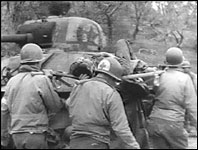752nd's Medical Detachment

When the 752nd entered combat in May 1944, the Medical Detachment consisted of one Medical Corps Officer (Captain Woodrow E. Lomas, Battalion Surgeon), and twenty enlisted men. At that time, the Medical Detachment was allotted three halftrack ambulances and one ¾-ton 4x4 command and reconnaissance car. In August 1944, the Medical Detachment T/O & E was changed, allotting three ¼-ton 4x4 cars in place of the halftrack ambulances. In addition, litter racks were added to the command and reconnaissance cars. Authorized strength of the Medical Detachment was changed to one Medical Corps Officer, one Medical Administrative Corps Officer, and eighteen enlisted men.
Upon entering combat, first aid teams were formed and attached to each line company to evacuate the sick and wounded from the field. These teams consisted of one non-commissioned officer and three aid men per ambulance. First aid teams remained with company maintenance to the rear of assaulting companies. When casualties occurred in forward areas, the tankers radioed company maintenance to send medics forward to evacuate the wounded to the Battalion Aid Station. From here, casualties were then taken to a Divisional Collecting Station, which was operated by whichever infantry division the 752nd was supporting at the time. This method of treatment and evacuation was considered satisfactory, and no changes were made throughout the combat period.
The medics of the 752nd Tank Battalion, like medics attached to any combat unit, were very much in harm's way as they performed their life-saving duties. In fact, the casualty rate among the tiny medical detachment was even higher than the casualty rate among the combat tank crewmen. Three of the 752nd's combat medics were killed in action. Six others were wounded in action, some of them so seriously that they were sent home for a long recuperation and eventual discharge. One medic was captured and spent the rest of the war in a prison camp.
Basic Field Manual:
First Aid For Soldiers
7 April 1943
64. FIRST AID FOR PERSONS INJURED IN TANKS - First-aid measures for persons injured in tanks must often be given very hurriedly, or delayed until removal of the person from the tank has been accomplished. Whenever the situation permits, tank casualties who are suffering much pain should be given an injection of morphine, should be kept warm, and should be moved as little as possible, evacuation being accomplished at the rallying point. If practicable, wounds should be dressed and simple splinting such as tying an injured leg to the uninjured leg, should be done before evacuation from the vehicle. When there are severe injuries which will cause the person to suffer much pain during his removal from the tank, an injection of morphine should be given before he is removed, unless morphine has been given within the last 2 hours (see par. 10). Removal can be accomplished either with or without the aid of belt straps, slings, harnesses, or other special equipment, always being very careful to avoid causing further injury during evacuation.

Click here to learn more about
tank battalion medical detachments
Researched
and Written by Robert J. Holt
Page Content Copyright 2002 - 2025 Robert J. Holt
All Rights Reserved